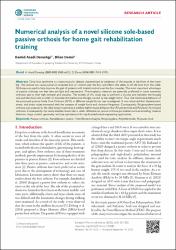| dc.contributor.author | DERESHGI, Hamid Asadi | |
| dc.contributor.author | Demir, Dilan | |
| dc.date.accessioned | 2023-03-16T05:32:09Z | |
| dc.date.available | 2023-03-16T05:32:09Z | |
| dc.date.issued | 2022 | en_US |
| dc.identifier.citation | Dereshgi, H. A., & Demir, D. Numerical analysis of a novel silicone sole-based passive orthosis for home gait rehabilitation training. European Mechanical Science, 6(4), 251-256. | en_US |
| dc.identifier.issn | 2587-1110 | |
| dc.identifier.uri | https://doi.org/10.26701/ems.1123082 | |
| dc.identifier.uri | https://hdl.handle.net/20.500.12294/3543 | |
| dc.description.abstract | Drop foot syndrome is a neuromuscular disease characterized by weakness of the muscles in the front of the lower leg. This disease can cause partial or complete loss of control over the foot and affects the ability to lift the foot from the ankle. Orthoses are used to help improve the gait of patients with limited control over the foot muscles. The most important advantages of passive orthoses are that they are light and inexpensive. Thermoplastic materials are generally preferred in lower extremity orthoses due to their high strength and elasticity. The novelty of this study was to examine the mechanical behavior of the proposed passive orthosis at different weight forces. It was observed that displacement, stress and strain values increased with the increase of weight force and vibration frequency. Consequently, Polypropylene-based orthosis was accepted as the ideal design material as it exhibits higher elastic behavior than Polyetherimide and Polylactic Acid-based orthoses. Consequently, this study enables researchers a useful reference on passive orthosis parameters such as modeling, material behavior, shape control, geometry, and size optimization for key biomechanical engineering applications. | en_US |
| dc.language.iso | eng | en_US |
| dc.publisher | Ahmet Çalık | en_US |
| dc.relation.ispartof | European Mechanical Science | en_US |
| dc.identifier.doi | 10.26701/ems.1123082 | en_US |
| dc.rights | info:eu-repo/semantics/openAccess | en_US |
| dc.subject | Passive Orthosis | en_US |
| dc.subject | Rehabilitation System | en_US |
| dc.subject | Finite Element Analysis | en_US |
| dc.subject | Polypropylene | en_US |
| dc.subject | Polyetherimide | en_US |
| dc.subject | Polylactic Acid | en_US |
| dc.title | Numerical analysis of a novel silicone sole-based passive orthosis for home gait rehabilitation training | en_US |
| dc.type | article | en_US |
| dc.department | Mühendislik ve Mimarlık Fakültesi, Biyomedikal Mühendisliği Bölümü | en_US |
| dc.authorid | 0000-0002-8500-6625 | en_US |
| dc.identifier.volume | 6 | en_US |
| dc.identifier.issue | 4 | en_US |
| dc.identifier.startpage | 251 | en_US |
| dc.identifier.endpage | 256 | en_US |
| dc.relation.publicationcategory | Makale - Ulusal Hakemli Dergi - Kurum Öğretim Elemanı | en_US |
| dc.institutionauthor | DERESHGI, Hamid Asadi | |
| dc.institutionauthor | Demir, Dilan | |


















